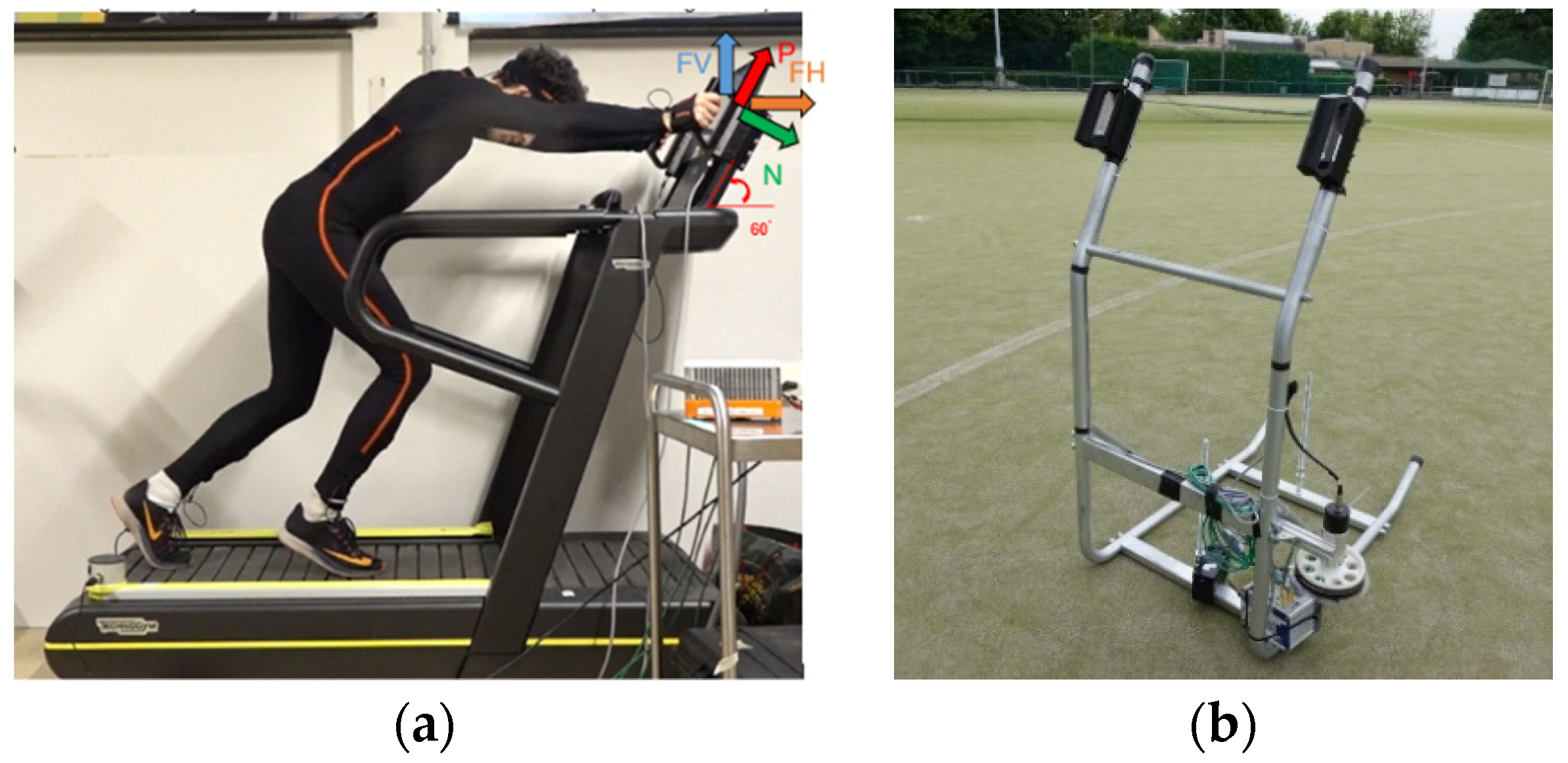Comparison between Indoor Sled Tests on the SkillrunTM Treadmill and Outdoor Field Tests at Increasing Sled Loads †
Abstract
:1. Introduction
2. Materials and Methods
2.1. Participants
2.2. Instruments and Procedures
2.3. Tests Protocol
- Two instrumented handles (same as indoor tests);
- One uniaxial accelerometer;
- One encoder to measure the sled’s speed;
- Somat eDAQ for data acquisition.
2.4. Measured Variables
- Trunk lean angle;
- Left and right hip angle (sagittal plane, flexion/extension);
- Left and right knee angle (sagittal plane, flexion/extension);
- Left and right ankle angle (sagittal plane, plantar/dorsiflexion);
- Total horizontal force produced (FH, in orange, Figure 2a);
- Total vertical force produced (FV, in blue, Figure 2a);
- Power output calculated with handles’ measured forces.
2.5. Data Analysis
3. Results
4. Discussion
- Experimental points are hard to obtain after the P–V curve maximum because a very lightweight sled (≈0 kg would be needed to reach maximum theoretical speed);
- Possible influence on the power output of the running aerial phase, which increases as the speed increases.
- RV seems to exponentially increase. We can speculate that higher sled loads can be pushed at higher running velocities in outdoor sprints;
- RP seems to be around one for lighter sled load and suddenly increased at higher loads. We can hypothesize that the indoor sprints on the SKILLRUNTM did not allow pushing very heavy loads due to ergonomic issues.
5. Conclusions
Funding
Acknowledgments
Conflicts of Interest
References
- Cavagna, G.A.; Kaneko, M. Mechanical work and efficiency in level walking and running. J. Physiol. 1977, 268, 467–481. [Google Scholar] [CrossRef] [PubMed]
- Kaneko, M. Mechanics and energetics in running with special reference to efficiency. J. Biomech. 1990, 23, 57–63. [Google Scholar] [CrossRef]
- Morin, J.B.; Petrakos, G.; Jimenez-Reyes, P.; Brown, S.R.; Samozino, P.; Cross, M.R. Very-heavy sled training for improving horizontal-force output in soccer players. Int. J. Sports Physiol. Perform. 2017, 12, 840–844. [Google Scholar] [CrossRef] [PubMed]
- Seitz, L.B.; Mina, M.A.; Haff, G.G. A sled push stimulus potentiates subsequent 20-m sprint performance. J. Sci. Med. Sport 2017, 20, 781–785. [Google Scholar] [CrossRef] [PubMed]
- Brughelli, M.; Cronin, J.; Chaouachi, A. Effects of Running Velocity on Running Kinetics and Kinematics. J. Strength Cond. Res. 2011, 25, 933–939. [Google Scholar] [CrossRef] [PubMed]
- Morin, J.B.; Samozino, P.; Bonnefoy, R.; Edouard, P.; Belli, A. Direct measurement of power during one single sprint on treadmill. J. Biomech. 2010, 43, 1970–1975. [Google Scholar] [CrossRef] [PubMed]
- Funato, K.; Yanagiya, T.; Fukunaga, T. Ergometry for estimation of mechanical power output in sprinting in humans using a newly developed self-driven treadmill. Eur. J. Appl. Physiol. 2001, 84, 169–173. [Google Scholar] [CrossRef] [PubMed]
- Cross, M.R.; Samozino, P.; Brown, S.R.; Morin, J.B. A comparison between the force-velocity relationships of unloaded and sled-resisted sprinting: Single vs. multiple trial methods. Eur. J. Physiol. 2017, 118, 563–571. [Google Scholar] [CrossRef]
- Cross, M.R.; Lahti, J.; Brown, S.R.; Chedati, M.; Jimenez-Reyes, P.; Samozino, P.; Eriksrud, O.; Morin, J.B. Training at maximal power in resisted sprinting: Optimal load determination methodology and pilot results in team sport athletes. PLoS ONE 2018, 13, e0195477. [Google Scholar] [CrossRef] [PubMed]
- Schmidt, M.; Rheinländer, C.; Frederic, K.; Wille, S.; Wehn, N.; Jaitner, T. IMU-based determination of stance duration during sprinting. Procedia Eng. 2016, 147, 747–752. [Google Scholar] [CrossRef]




| Athletic Level | Height (m) | BW (kg) | Age | |
|---|---|---|---|---|
| ATHLETE 1 | Soccer player | 1.74 | 72 | 23 |
| ATHLETE 2 | Soccer player | 1.79 | 74 | 23 |
| Indoor Sled Loads (kg) | Outdoor Sled Loads (kg) | |
|---|---|---|
| ATHLETE 1 | 15-30-45-60-75-90-100 | 30-45-60-75-90-100 |
| ATHLETE 2 | 15-30-45-60-75 | 30-45-60-75 |
| Athlete | RMSEIN−OUT (W) | Lopt,out [kg] | Lopt,in [kg] | ||
|---|---|---|---|---|---|
| 1 | 31 | 12.7 | 14 | 61 | 50 |
| 2 | 99 | 12.7 | 13 | 68 | 48 |
| Total Load (kg) | |||||
|---|---|---|---|---|---|
| 30 | Outdoor | 70°/−1° | 121°/14° | 35°/−37° | 51°/30° |
| Indoor | 70°/−3° | 115°/5° | 33°/−45° | 47°/36° | |
| 45 | Outdoor | 81°/−6° | 128°/13° | 34°/−35° | 52°/30° |
| Indoor | 68°/0° | 115°/9° | 26°/−42° | 46°/34° | |
| 60 | Outdoor | 67°/−1° | 112°/15° | 32°/−35° | 51°/28° |
| Indoor | 70°/3° | 107°/11° | 36°/−40° | 45°/33° | |
| 75 | Outdoor | 72°/−3° | 105°/12° | 35°/−35° | 44°/28° |
| Indoor | 70°/1° | 106°/9° | 33°/−37° | 41°/32° |
Publisher’s Note: MDPI stays neutral with regard to jurisdictional claims in published maps and institutional affiliations. |
© 2020 by the authors. Licensee MDPI, Basel, Switzerland. This article is an open access article distributed under the terms and conditions of the Creative Commons Attribution (CC BY) license (https://creativecommons.org/licenses/by/4.0/).
Share and Cite
Volpe, A.; Marcolin, G.; Fedele, G.; Zanuso, S.; Bettio, G.D.; Petrone, N. Comparison between Indoor Sled Tests on the SkillrunTM Treadmill and Outdoor Field Tests at Increasing Sled Loads. Proceedings 2020, 49, 18. https://doi.org/10.3390/proceedings2020049018
Volpe A, Marcolin G, Fedele G, Zanuso S, Bettio GD, Petrone N. Comparison between Indoor Sled Tests on the SkillrunTM Treadmill and Outdoor Field Tests at Increasing Sled Loads. Proceedings. 2020; 49(1):18. https://doi.org/10.3390/proceedings2020049018
Chicago/Turabian StyleVolpe, Alessandro, Giuseppe Marcolin, Giuseppe Fedele, Silvano Zanuso, Gabriele De Bettio, and Nicola Petrone. 2020. "Comparison between Indoor Sled Tests on the SkillrunTM Treadmill and Outdoor Field Tests at Increasing Sled Loads" Proceedings 49, no. 1: 18. https://doi.org/10.3390/proceedings2020049018
APA StyleVolpe, A., Marcolin, G., Fedele, G., Zanuso, S., Bettio, G. D., & Petrone, N. (2020). Comparison between Indoor Sled Tests on the SkillrunTM Treadmill and Outdoor Field Tests at Increasing Sled Loads. Proceedings, 49(1), 18. https://doi.org/10.3390/proceedings2020049018





